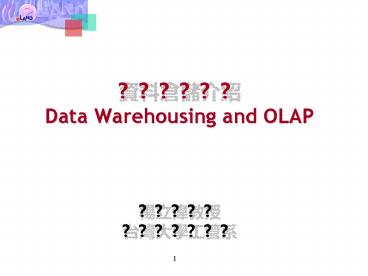?????? Data Warehousing and OLAP ????? ??????? PowerPoint PPT Presentation
Title: ?????? Data Warehousing and OLAP ????? ???????
1
??????Data Warehousing and OLAP????????????
2
Agenda
- Introduction
- Data Warehouse Theory
- System Features
- Demo
- Discussions
3
1. Introduction
4
1.1 Introduction
- A data warehouse is a subject-oriented,
integrated, time-variant, nonvolatile collection
of data in support of management decisions
5
1.1 Introduction (contd)
- How are organizations using data warehouse ?
- Increasing customer focus, which includes the
analysis of customer buying patterns. - Repositioning products and managing product
portfolios by comparing the performance of sales
by time or regions, in order to fine-tune
production strategies - Analyzing operations and looking for sources of
profit - Managing the customer relationship, making
environmental corrections, and managing the cost
of corporate assets
6
1.2 Data Warehouse Characteristics
- It is a database designed for analytical tasks,
using data from multiple applications - It supports a relatively small number of users
with relatively long interactions - Its usage is read-intensive
- Its content is periodically updated
7
1.2 Data Warehouse Characteristics (contd)
- It contains current and historical data to
provide a historical perspective of information - It contains a few large tables
- Each query frequently results in a large result
set and involves frequent full table scan and
multi-table joins
8
1.3 Datawarehousing
- The Processing of constructing and using data
warehouses
Heterogeneous Data Sources
Data Cleaning
Data Integration And Consolidation
Interactive Analysis
Making Strategic Decisions
Constructing Data warehouse
Using Data Warehouse
9
1.4 Three-tier System Architecture
10
2. Data Warehouse Theory
11
2.1 Data Warehouse Theory
- Why not use Database directly ?
- The update-driven approach is inefficient.
- Potentially expensive for frequent queries.
- Use Data warehouse instead
- The query-driven approach is enough for making
strategic decisions. - Separate the operational DBMS for daily and
critical operations.
12
2.2 Data Cube
- A multidimensional, logical view of the data
- Concept hierarchy
- Multiple data granularity ????????
- Data summarization ????
- Data generalization ?????
13
- A 3-dimension Data Cube
14
- Drill-down on time data for Q1
- Roll-up on address
15
- Adding a dimension supplier
16
2.3 Efficient Data Cube Computation
- The challenges 2N combinations
- Concept hierarchy and Aggregations
- makes it more complicated !
- Materialization of data cube ????
- Materialize every, none, or some ?
- Algorithms for selection
- Based on size
- Based on sharing,
- Based on access frequency.
17
2.4 On-Line Analytical Processing (OLAP)
- Fast on-line processing of data cubes or
multi-dimensional databases - OLAP operations
- Drilling
- Pivoting ????
- Slicing and Dicing
- Filtering, etc.
18
2.4 On-Line Analytical Processing (Contd)
- A multidimensional, logical view of the data.
- Interactive analysis of the data (drill, pivot,
slice_dice, filter) and Quick response to OLAP
queries. - Summarization and aggregations at every dimension
intersection. - Retrieval and display of data in 2-D or 3-D
cross-tabs, charts, and graphs, with easy
pivoting of the axes. - Analytical modeling deriving ratios, variance,
etc. and involving data across many dimensions. - Forecasting, trend analysis, and statistical
analysis.
19
3. System Feature
20
3.1 Data sources supported
- ODBC-compatible DBMS
- Oracle, Microsoft SQL, MySQL, IBM DB2, etc.
- Files
- MS Access, MS Excel, etc.
- Text files (CSV-format)
21
3.2 Data Cleansing ????
- Database schema translation
- Field selection and mapping
- Field re-naming
- Field aggregating and deriving
- Data filtering
- Data value conversion
- Data value mapping
- Data value function
- Date value conversion and decomposition
22
3.3 Building of Data Cube
- Support for multi-dimension data
- Support for concept hierarchy
23
3.5 Interactive Front-end Tools
- User-defined multi-dimension
- User-defined dimension hierarchy
- User-defined data granularity
- Real-time graph capabilities
- Bar chart
- Pie chart
- Line chart
24
3.6 Other features
- Web-based OLAP GUI
- Easy to access from Internet
- Easy to integrated with other systems
- Import / Export capability
25
4. Demo
26
5. Discussions
27
5.1 Roadmap
- Integrated with Data mining
- Major Group / Sales Analysis ????
- Prospects Analysis and Forecast ?????????
- Association of Customers and Sales ????
- Market Segment Recommendation ????
- Other Business Intelligence application
- Integrated to e-Marketing
- 1-to-1 Personalization Recommendation ?????
- Target marketing ????
- Loyalty program ???????

